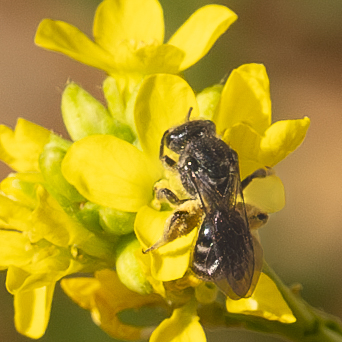I’m still trying to figure out macro photography with the Sony, at least when my Nikon batteries are drained. I don’t use the Nikon as much anymore, since I’m primarily photographing birds, but when the bug itch bites, I switch back to my trusty Nikon with the 200mm macro lens. Unless, as mentioned, the batteries are drained, in which case I use my cheap Sigma 70mm macro on the Sony. And the results, at least so far, are underwhelming. Nevertheless, today I saw and got bad pictures of the first native bee I’ve noticed foraging on the ubiquitous non-native mustard we have on the property:

I’m pretty sure it’s a halictid bee, and it’s black (not green) and has bands on its abdomen. That hints at membership of the fairly widespread and abundundant genus Halictus. From this photo, I wouldn’t hazard a guess as to species, but there are (apparently) seven possibilities in California, and (at least according to one website) only about four on the central coast: H. farinosus, H. ligatus, H. rubicundus, and H. tripartitus (but that’s got a metallic, greenish tinge).
This bee has black legs, so we can rule out H. rubicundus, the orange-legged furrow bee.
The most likely candidate would be the most abundant halictid, H. ligatus, according to Wikipedia “one of the most abundant and readily identifiable bees in North America, encompassing a wide range of aridities and altitudes.”
After the heat wave passes (today’s supposed to be the last day of 105+ degrees), and after my Nikon’s batteries are charged back up, I’ll try to get better images. But that’s what I saw this morning in the field. Oh, and I saw a few chicory flowers growing along with a couple of even more invasive non-natives (mustard and starthistle):

On our local easements, sometimes you can spot the pretty, but non-native and somewhat invasive, chicory flower. That is, as long as you watch your step so you don’t get gouged by the much worse pest plant, the yellow starthistle.
